Abstract
Synthetic solutions assimilating irrigated groundwater containing varying concentrations of humic acid (10 mg/L), saline (10–35 g/L) and metal agents (5–10 mg/L), were processed through a ceramic microfiltration membrane (Sterilox Ltd., 0.5 μm). This was done with enrichment schemes using polymeric coagulants (PDADMAC) applied to enhance the removal of the above-mentioned pollutants. The study was conducted with the scope of investigating the feasibility of sequential and hybrid coagulation and microfiltration as a method of choice for drinking water treatment. Membrane microfiltration is easily scalable into various arrangements, allowing versatility in operation and enrichment schemes, with a relatively lower cost which other treatment practices do not allow. The highest humic acid removal, 91.11% was achieved with hybrid coagulation.
1. Introduction
Middle East and North Africa are currently experiencing high population growth, the highest of the known world, with diverse social and financial developments across the region [1]. As such, clean water demand and wastewater production are steeply increasing while the gap between water demand and supply is getting wider [2]. To tackle this, other sources of water such as groundwater, water hold by dams, brackish water, and water reuse generated by wastewater treatment have to be considered. Underground water can be the major water source which can be pumped to the surface using electrical or diesel generators for remote areas to drive various types of pumps [3].
However, groundwater is susceptible to contaminants that need to be removed as for the water to be considered safe for consumption. Groundwater contaminants include natural organic matter (NOM), synthetic detergents, nutrients such as phosphate and ammonia, and heavy metals (HM). NOM is a complex mixture of compounds including fulvic acid, humic acid (HA) [4,5], and humin formed through degradation of plant and animal material in the environment and is found in all water sources. It is composed of a range of small, low molecular weight species such as carboxylic amino acids, proteins and larger, higher molecular weight species (from 0.5–30 kDa) such as humic and fulvic acids. In high concentrations, NOM can be toxic to aquatic organisms with potential health risks to humans if directly exposed or be bioaccumulated through food chains [6]. Heavy metals, such as mercury, copper, and lead can cause serious health effects in excessive amounts, including reduced growth and development, autoimmune diseases, cancer, organ damage, nervous system damage, and in extreme cases, death [7].
Drinking water treatment, mainly aims to eliminate such contaminants or at least, minimize their concentrations, thereby producing water that is suitable for specific end-use. Water treatment methods include both physical methods such as sedimentation and filtration (membranes, media filtration) and chemical methods such as coagulation, pH adjustment, coagulations, addition of anti-scalants and acids [8,9].
Nowadays, integrated membrane systems treatment is becoming widely popular because of their feasibility, process reliability, plant availability, modularity, relative insensitivity in case of raw water and lower operating costs. Integrated membrane systems have also been proposed as the most suitable solution for decentralized wastewater treatment [10,11], which is needed because of the generation of waste from rural industry (farming, livestock breeding, biogas generation through anaerobic digestion) or the local population [12]. The judicial use of membranes can decrease the capital cost, reduce chemical usage and require little maintenance [12]. They offer high productivity and low operational cost compared to other competing technologies, since there is no phase change of water and minimal or no use of chemical additives [13]. Ceramic membranes are increasingly employed in the drinking water and wastewater treatment industries when compared with organic and polymeric membranes because of their resistance to extreme operating conditions and cleaning protocols [14]. This allows longer service lifetime and highly efficient filtration performance. Tubular membranes modules provide a modest surface area to volume ratio, and thus the highest cost per unit area of all cylindrical membrane geometries, but also provide potentially the greatest turbulence promotion and the best access to the membrane surface [15].
However, membranes are susceptible to fouling, especially but not exclusively, in cases of membranes with tighter pores such as ultrafiltration and nanofiltration modules, impending their continuous operation. NOM is one of the main culprits when it comes to fouling, as the particles bind to each other and to membrane surfaces [16,17]. Chemical and microbial agents including suspended particles, micro-organisms, and heavy metals contribute further to fouling. Several strategies such as chemical cleaning protocols and backflushing with air or liquids, are in place so the separation and mechanical characteristics of membranes should not change in the long run.
Other strategies include combining coagulation with either inorganic or organic coagulants, with membrane treatment which can potentially enhance pollutants retention and reduce membrane fouling. Precipitation of coagulated colloids at high coagulants concentration or high ionic strength in the feed reduces the feasibility of inorganic substances as coagulation aids, but organic coagulants have recently been preferred as they do not experience high precipitation, constituting them easier to handle.
Therefore, the purpose of this study is to investigate the effectiveness of a polyelectrolyte coagulant namely PDADMAC combined with microfiltration for the effective treatment of synthetic ground water comprised of varying concentrations of metals, salts, and humic acid. It aims to practically test the applicability of such an operation at a commercialized industrial market, focusing on the water treatment industry. Microfiltration as having relatively larger pore size, can be a cost-effective option, offering longevity and efficient separation if combined with coagulation. The proposal is that by using tangential cross flow microfiltration (MF) combined with organic coagulation PDADMAC and operated into two different modes, sequential coagulation-microfiltration and hybrid coagulation microfiltration would result in enhanced humic acid removal consequently promoting sustainability and minimizing the impact of discharged waste.
2. Materials and Methods
2.1. Materials
Powdered Chemicals, Chemical Solutions, and Polymer Coagulants
Powdered humic acid (MWCO 4.1 kDa) and metal salts (purity > 97%) namely copper (II) nitrate, cadmium nitrate, iron (III) nitrate, nickel (II) nitrate, lead (II) nitrate, and zinc nitrate, were obtained from Sigma-Aldrich, Dorset, UK. NaCl (purity > 99.5%) was purchased from Fisher Scientific, Loughborough, UK. Solutions of varying concentrations were prepared in deionized water. A total of 0.0986 g of Cu(NO3)2, 0.0967 g of Zn(NO3)2, 0.0702 g of Cd(NO3)2, 0.1033 g of Ni(NO3)2, 0.0534 g of Pb(NO3)2, and 0.0712 g Fe(NO3)3 were dissolve in 200 mL of deionized water to make a stock solution of 1 g/L total metals concentration, replaced on a weekly basis. Regarding humic acid, a stock solution at 1 g/L concentration and pH ≥ 9 was weekly prepared and stored at 4 °C. Of this, solutions of 10–mg/L concentration were prepared through dilution. Mixture solutions of humic acid, salts, and heavy metals were formulated from the above-mentioned solutions. The solutions were stirred at 400 rpm for 60 min and their pH was adjusted to 7, using 0.1 M of NaOH or HNO3. Poly-diallydimethylammonium chloride, PDADMAC (C8H16NCl)n, a commercial liquid emulsion polymer, was supplied by ACCEPTA Ltd., (Manchester, UK). Solutions of varying concentrations were prepared in deionized water.
2.2. Methods
2.2.1. Experimental
Microfiltration Membrane
A monolithic tubular ceramic (α-Al2O3) membrane of 0.006284 m2 area, nominal pore size 0.5 μm, 50% porosity by Sterilox Ltd. (Skellingthorpe, UK) was used for this work. Prior to each experimental procedure, the membrane was removed from its casing and conditioned by being immersed in a 70 °C 1% v/v NaOH solutions for 2 h in order to enhance pore opening and then it was repeatedly rinsed with deionized water at 22 °C for 30 min. The membrane was chemically cleaned at the end of each experimental procedure, using a series of alkaline and acidic solutions with intermittent washes with deionized water (1% v/v NaOH, 60 min run, 2% v/v sodium hypochlorite 60 min run, 2% v/v nitric acid 60 min run) regime. Afterward, the membrane was rinsed with MilliQ water and stored in MilliQ water until the next experiment. Before starting a new test, the ceramic membrane was characterized with MilliQ water at a transmembrane pressure (TMP) of 1 bar to verify the flux. A new measurement with the membrane was only started if the flux had not changed. All filtration experiments were provided in triplicate.
Microfiltration Unit Design
A bench scale microfiltration rig (Figure 1) of the following dimensions W–290, L–340, H–430 mm weighting 16 kg was designed and developed to conduct the experimental trials in a feed recycle arrangement. The filtration rig was composed of a stainless steel jacketed feed/recirculation tank of 500-mL working volume, a positive displacement gear pump (Ismatec, SS316/PEEK, Cole-Parmer GmbH, Wertheim, Germany) providing a tangential flow rate, a rotameter, a pressure gauge, four valves, and a tubular membrane housing that hosted the single layer tubular membrane. The volumetric feed flowrate through the module was kept in a range of 1.0–2.0 L/min at pressures up to 2.0 bar. It is controlled by adjusting the speed setting on the pump (variable speed controller) and adjusting the regulation valve. The amount of permeate collected as function of time was measured by a digital balance (XB 3200C, Precisa, Dietikon, Switzerland) interfaced to a PC through a user-friendly software (Education Program, v3.02, Precisa, Dietikon, Switzerland).
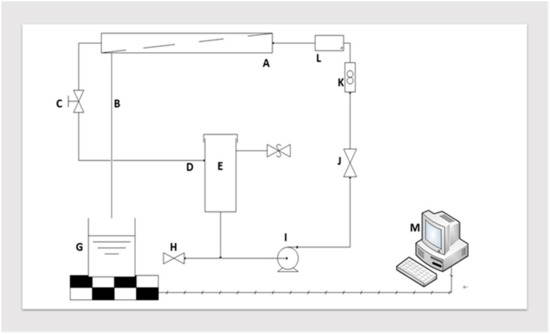
Figure 1.
(a) Tubular membrane module; (b) permeate recovery vessel; (c) pressure control valve; (d) recycle line; (e) jacketed process vessel; (f) pressure and safety valve; (g) digital balance; (h) drain valve; (i) re-circulation pump; (j) flow control valve; (k) flowmeter; (l) pressure gauge; (m) personal computer.
2.2.2. Processing Schemes
The artificial streams were processed using two schemes (Figure 2) namely sequential coagulation and microfiltration where the coagulant is added into the synthetic mixtures prior to filtration, and hybrid coagulation where the coagulant was added to the feed vessel simultaneously with the synthetic mixture and filtered. Both schemes aimed to enhance the retention of humic acid by the membrane. The schemes are described in further detail below.
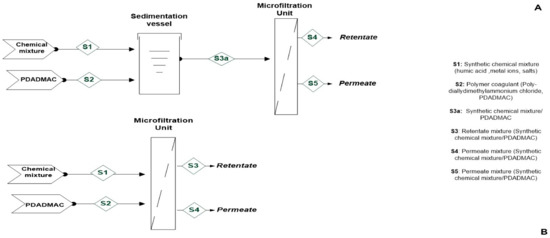
Figure 2.
Simplified process flow diagrams (PFD) depicting processing schemes namely (A) sequential coagulation-microfiltration and (B) hybrid coagulation-microfiltration used for the artificial groundwater treatment.
Sequential Coagulation–Microfiltration
The desired quantity of PDADMAC (1 mg/L) were added at a 5% v/v of the synthetic mixture containing 10 mg/L of humic acid of a total volume of 0.5 L, then the solution was mixed at 250 rpm for 5 min and then at 30 rpm for 15 min, and then left to act upon 1 h and then filtered at feed flow rate of 60, 90, and 120 L/h and operating pressures of 1, 1.5, and 2 bar. The experimental approach of one variable at a time (OVAT) was taken to test the effect of the different components of the synthetic mixture on their retention from the membrane. This was done by varying the concentration of one constituent while keeping the other components constant, in this case NaCl (10, 25, 35 g/L) and metals solution (5, 10 mg/L). The pH of solutions was adjusted to the desired value of 7, by adding 0.1 M NaOH or HNO3 immediately before the experiments.
Hybrid Coagulation–Microfiltration
Total of 1 mg/L of PDADMAC was added to 5% v/v of the synthetic mixture containing 10 mg/L of humic acid of a total volume of 0.5 L while in the feed vessel of the microfiltration rig. This was then filtered immediately at feed flow rate of 60, 90, and 120 L/h and operating pressures of 1, 1.5, and 2 bar. The experimental approach of one variable at a time (OVAT) was again taken to test the effect of the different components of the synthetic mixture on their retention from the membrane. This was done by varying the concentration of one constituent while keeping the other components constant, in this case NaCl (10, 25, 35 g/L) and metals solution (5, 10 mg/L). The pH of solutions at 7 was adjusted by 0.1 M NaOH or HNO3 immediately before the experiments.
2.2.3. Analysis of Physicochemical Characteristics
The HA concentration in permeate and retentate solutions were quantified by measuring the UV adsorption at 254 nm (Shimadzu UVmini-1240, Milton Keynes, UK) using a quartz cuvette. Further analysis was made by measuring the TOC content using an automatic analyzer with auto-sampling (TOC-VCPH, Shimadzu, ASI-V Autosampler, Shimandzu, Milton Keynes, UK). Sodium chloride and heavy metal concentrations were found not causing any interference regarding measuring humic acid concentrations [18]. Heavy metal concentration, in the permeate and retentate solutions, were analyzed using an atomic absorption spectrophotometer, AAS (Varian AA 240FS, Agilent, Santa Clara, CA, USA). The pH of solutions was adjusted to 7 by 0.1 M NaOH or HNO3 immediately before the experiments. pH values were measured with a Jenway 3540 pH meter (Keison Products, Essex, UK). All glassware used were soaked in 2 M NaOH or in citric acid (2%) for 24 h and then rinsed with water to remove any organic contamination or heavy metals, respectively.
2.3. Theoretical
Determination of the Filtration Parameters
For the determination of the permeate flux (Jpermeate, m3/m2 s) equation (1) was used [19,20],
where Qf is the volumetric flow rate (L/h), Am is the membrane area (m2), V is the volume feed (L), and t is time (h). Conversion of units took place where necessary.
Transmembrane pressure (ΔP, TMP) was defined as
The observed retention (Rret, %) of the acids was determined as
where Cp,i is the observed concentration (mM) of the acid in the permeate and Cr,i is the observed concentration (mM) of the acid in retentate [21].
3. Results and Discussion
3.1. Retention of Humic Acid under Various Salts Concentrations
The effect of various salts concentrations (10–35 g/L) in various operating conditions, on the retention of humic acid was tested. In both processing schemes, three different transmembrane pressures were tested (Figure 3). It was found that varying the TMP, defined as the pressure decrease is a result of feed passing through the elements [22], had very little effect on the retention of humic acid.
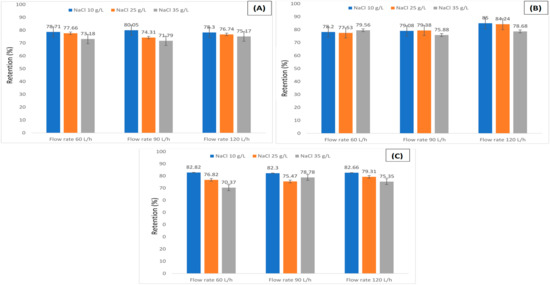
Figure 3.
Effect of varying amounts of salinity in retention of humic acid during the sequential coagulation microfiltration processing scheme and different hydrodynamic conditions i.e., TMP (A) 1 bar, (B) 1.5 bar, and (C) 2 bar.
In sequential coagulation-microfiltration, optimum results are observed when the system was operated at 2 bar TMP (Figure 3C), while in hybrid coagulation-microfiltration 1.5 bar (Figure 4B). A TMP over 1 bar offers higher retention across the various flow rates and concentrations (Figure 3 and Figure 4), however the difference in retention in both treatment scenarios is not high. Previous research [23,24,25] has showed a small effect of TMP on HA retention especially in cases of membranes with larger pores (MF, UF) and this phenomenon is confirmed by the current results. Higher retention, regardless of TMP or flow rate is also observed in lower salts concentration (Figure 3 and Figure 4) with both processes. The reduction on HA retention, in higher salts concentrations (Figure 3 and Figure 4) can be attributed to the HA macromolecules that may be compressed by high ionic strength leading to strengthened aggregation and cake formation [26,27]. This is known as double layer compression phenomenon [28]. The phenomena indicate that the area surrounding the particle surface charge, in this case the anionic HA particles are attracted by excess charge in the solution represented by the cation sodium ions, forming a layer called the diffusion layer. When more counter-ions are added to the suspension and being attracted toward the HA particles as a result of salinity increase, the counter-ions would cause the diffusion layer to compress. At higher ionic strength, there will be a reduction in the repulsive electrostatic interactions between the charged molecule and the charged membrane that would allow the organic molecules for a closer approach to the membrane surface and the easier entrapment of these molecules in permeate flowing through the membrane [29]. Furthermore, HA molecules small size at high ionic strength and the HA small molecules configurations are more spherical preceding to increase diffusivities [26], therefore decrease retention [26,30,31].
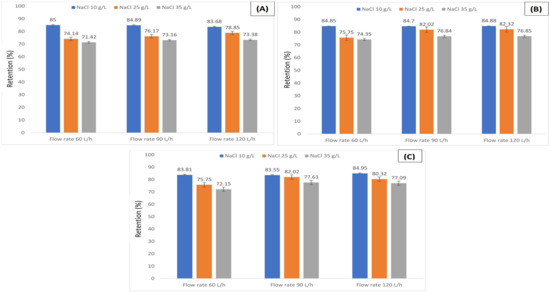
Figure 4.
Effect of varying amounts of salinity in retention of humic acid during the hybrid coagulation microfiltration processing scheme and different hydrodynamic conditions i.e., TMP (A) 1 bar, (B) 1.5 bar, and (C) 2 bar.
The effect of three different flow rates in humic acid retention have also been tested. This is one of the hydrodynamic parameters that could potentially influence the membrane filtration processes, resulting into cake layer and pore blockage. In both processing schemes, the flowrate does not seem to influence significantly the retention of humic acid at this instance. The formation of humic acid cake layer is caused by an electrostatic interaction, and the level of accumulation is based on a balance between convective transport of HA solutes toward the membrane and back diffusion transport [32].
For the all set of flowrate values studied, mostly, there were slight increases in HA retentions when the flowrate was increased, in lower salinity content. Although retention is high in both processing scenarios, hybrid coagulation-microfiltration offers better results (Figure 4) across different range of salts concentrations, TMP, and flowrate conditions.
3.2. Retention of Humic Acid under Various Metals Concentrations
Humic acid is an anionic polyelectrolyte, with functional groups containing oxygen that even in small concentrations is reactive with heavy metal (HM) ions [33]. It is, tending to bind with these elements especially, Cu2+, Cd2+, Fe3+, Zn2+, Ni2+, and Pb2+ [34] in soil and groundwater and thus play an important role in the transport of metal ions in the aqueous environment [34]. Heavy metals were incorporated in the testing solution in the form of nitrate salts. Nitrate is a well-known pollutant of aquifers; its existence-in high amounts- is often attributed to extensive human activity as it is the main component of commercial fertilisers. However, nitrate removal using the current treatment schemes has not been evaluated.
Figure 5 demonstrates an increase in humic acid retention as a function of increasing heavy metals (HM) concentration in the feed, when the stream was treated with sequential coagulation and microfiltration. This increase is significant and is independent of the hydrodynamic parameters, namely TMP and flowrate, although higher retention is observed when the system was operated at 1.5 bar TMP. A similar trend is observed when the streams are treated with hybrid coagulation and microfiltration (Figure 6), however even with lower heavy metals concentration the retention of humic acid is higher, varying between 81.63% and 86.02% for 5 mg/L, compared to 74.36 and 79.08% when sequential coagulation microfiltration was used.
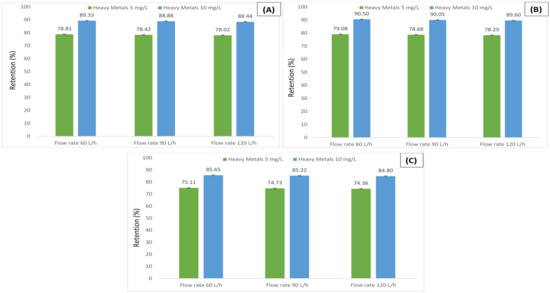
Figure 5.
Effect of varying amounts of heavy metals in retention of humic acid during the sequential coagulation microfiltration processing scheme and different hydrodynamic conditions i.e., TMP (A) 1 bar, (B) 1.5 bar, and (C) 2 bar.
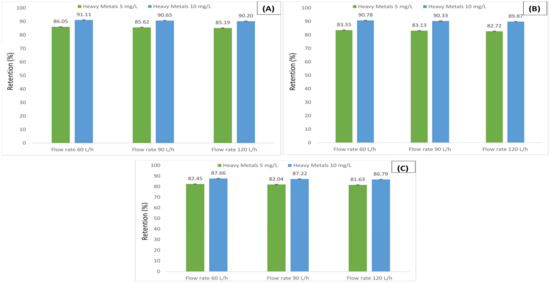
Figure 6.
Effect of varying amounts of heavy metals in retention of humic acid during the hybrid coagulation microfiltration processing scheme and different hydrodynamic conditions i.e., TMP (A) 1 bar, (B) 1.5 bar, and (C) 2 bar.
Previous research [35] is confirmed the above-mentioned results. It has been suggested that PDADMAC and metal ions do not compete for the same sites on the HA molecule, while metal ions might have auto-flocculating action [35]. The aggregation of HA is promoted by the presence of cations, via charge neutralization and cation bridge formation [36,37] with considerable affinity by carboxylate and phenolate groups of HA is recognized for divalent inorganic cations, which can bind to HA molecules in solution [38], or at the surface of solid HA particles [38,39]. Divalent cations significantly increased the HA aggregation through the formation of intra- or intermolecular bridges between the negatively charged HA molecules [40].
3.3. Effect of Processing Schemes in the Membrane Flux
When MF is used for HA containing water treatment, a tight cake layer might be formed on the membrane surface [41]. This tight cake layer reduces the permeate flux. Therefore, for water treatment, it is more desirable to combine the use of coagulation and membranes filtration processes because the coagulation give HA the opportunity to join with other particles present in water before HA reaches the membrane surface [42]. Coagulation would aggregate HA particles and will produce larger size particles that would not block membrane pores, thus gives the chance for the liquid to pass through the MF membrane. The overall flux of the system with both operating scenarios is demonstrated in Table 1; comparison is also made with microfiltration data collected from previous published work of the group [18] where filtration is used as a standalone treatment process. It becomes apparent that flux is significantly lower when compared with the other two treatments. Furthermore, a decrease in the flux, in the case of sequential coagulation-microfiltration is observed as a result of increasing the salinity concentration in the feed solution. HA aggregates deposit on the membrane surface by the convective flow. Increasing the salinity (ionic strength) would increase the electrostatic shielding between the humic acid aggregates causing a formation of tightly packed, less permeable HA deposits [18,43]. The lower flux values may be explained by an increase in the thickness of HA layer deposited on the membrane surface because of the decrease in electrostatic reduction between the HA macromolecules in the feed and those already deposited on the membrane [18]. Flux through the tight aggregates is normally low unless the aggregates accumulate as a porous cake of large particles [29]. Obviously, at high HM content, large HA aggregates are formed and as a result a more open and less dense cake layer from HA aggregates deposited on the membrane surface [18]. On the other hand, when hybrid coagulation and microfiltration is being applied the flux remains elevated, relatively unaffected from the content of salts or metals. Similar results have been observed [44] and have been attributed to the formation of a porous cake possibly less prone to be absorbed on the membrane surface, decreasing the pore blockage.

Table 1.
Flux of the solution under varying conditions (salinity and heavy metals (HM) concentration) by the different processing schemes.
3.4. Effect of Processing Schemes in the Membrane Structure
The condition of the membrane post-treatment has been evaluated using the atomic force microscopy (AFM), and can be described in terms of membrane surface topography and pore distribution [45,46,47]. AFM provides three-dimensional images with resolution at or near the atomic level and can also quantify properties such as surface features, surface morphology, surface roughness, elasticity and adhesiveness, membrane pore size and porosity, helping evaluate foulant layer morphology [48,49]. Changes on the membrane surface are noticeable from the images (Figure 7).
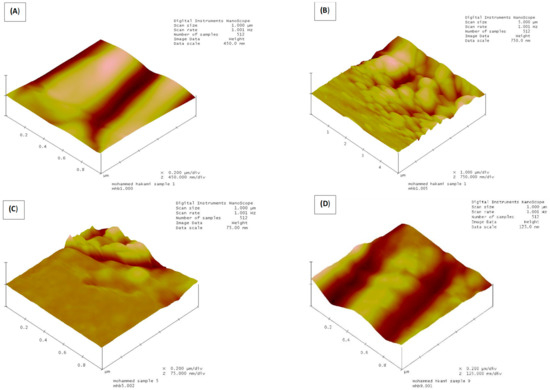
Figure 7.
(A) Atomic force microscopy (AFM) image of untreated dry membrane (scan area 1 μm × 1 μm), (B) AFM image of treated with 1% v/v NaOH (scan area 1 μm × 1 μm), (C) AFM image of fouled membrane (sequential coagulation-MF) (scan area 1 μm × 1 μm), (D) AFM image of fouled membrane (hybrid coagulation-MF) (scan area 1 μm × 1 μm).
The measured mean pore size under air environment is 330.94 nm (0.33 μm) with the membrane porosity measured for the dry untreated was 10.32%. (Figure 7A). Mean surface roughness has been measured, (Table 2) and a compelling reduction, by two-third of the roughness can be seen between the dry untreated membrane and the other three preparations. The root mean square (RMS) roughness decreased from 33.75 nm for the untreated dry membrane to 10.00 nm for the pretreated membrane. This is could be related to the NaOH that might react to an extent with the ceramic components (alumina, zirconia, yttria) causing pore swelling. The roughness data also show a reduction of almost half between the pretreated membrane and the membrane tested after treatment with sequential coagulation microfiltration. Roughness decreased from 10.00 nm to 5.55 nm indicating that fouling had built up on the membrane surface. The mean maximum range (MMR) from the images can be used for a comparison and as an evidence of membrane fouling. The MMR for the untreated membrane was 183.19 nm. On the other hand, the MMR of the treated membrane soaked by NaOH was 71.68 nm, while it was 59.34 nm for the membrane fouled by sequential coagulation-microfiltration. Coagulation by PDADMAC not only increased HA retention, but also decreased fouling on membrane surface as can be seen from the results obtained from the degree of roughness on Table 2 in both the treatment scenarios, however the results with hybrid coagulation-microfiltration suggest that this treatment scheme enhances longevity of the equipment and length of operation. This is also supported by the RMS roughness value for the membrane fouled by the hybrid coagulation-microfiltration operation that was 9.82 nm, which is close to the RMS for the virgin membrane soaked by NaOH 10.00 nm. The MMR of the hybrid coagulation-microfiltration scheme membrane was 65.84 nm suggesting that this processing scheme was optimum results. Images of the membranes (Figure 7) were obtained for four different membrane preparations, namely untreated dry membrane, pre-treated membrane with 1% v/v NaOH, and membrane imaged post processing schemes.

Table 2.
Physical characteristics of the microfiltration (MF) membrane under different treatment conditions defined by AFM.
4. Conclusions
Water scarcity is an emerging phenomenon across the known world. Climate change causing prolong periods of drought and is a contributing factor into the current situation. Groundwater, although complex in composition with contaminants such as NOM can be a sustainable source of water of the expanding population. The detrimental effects in water quality of the main component of nominal organic matter, humic acid, and other contaminants such as metal ions and salts have been long known. Membrane treatment such as microfiltration combined with coagulation can be an effective strategy for contaminants removal.
This paper has shown that
- Ceramic tangential cross flow microfiltration combined with coagulation is an effective treatment for humic acid removal.
- Two processing schemes were tested, namely sequential coagulation and microfiltration and hybrid coagulation and microfiltration. Hybrid coagulation and microfiltration is a highly effective treatment scheme in all cases, with an elevated flux when compared with sequential coagulation and microfiltration.
- Several hydrodynamic conditions namely transmembrane pressure and flowrate were tested, concluding that 1.5 bar of transmembrane pressure offers the higher humic acid retention.
- Hybrid coagulation and microfiltration has also the least effect of the membrane surface compared with the other processing scheme, promoting longevity of the membrane equipment used.
Author Contributions
Conceptualization M.W.H., N.H.; methodology, M.W.H., N.H.; formal analysis M.W.H., N.H.; investigation M.W.H.; data curation, M.W.H., A.A., M.-P.Z., N.H.; writing—original draft preparation, M.-P.Z., M.W.H., A.A.; writing—review and editing, M.-P.Z., M.W.H., A.A.; supervision, N.H.
Funding
This research received no external funding.
Acknowledgments
The authors would like to thank fellow researchers in the College of Engineering, Swansea University for their valuable advice in the research discussed here. This manuscript was written and submitted for potential evaluation at University of South Wales (USW), Sustainable Environment Center (SERC).
Conflicts of Interest
The authors declare no conflict of interest.
References
- Available online: https://www.prb.org/Populationtrendsandchallengesinthemiddleeastandnorthafrica/ (accessed on 29 August 2019).
- Alkhudhiri, A.; Darwish, N.B.; Hilal, N. Analytical and Forecasting Study for Wastewater Treatment and Water Resources in Saudi Arabia. J. Water Process Eng. 2019, 32. [Google Scholar] [CrossRef]
- El-Ghonemy, A.M.K. A small-scale brackish water reverse-osmosis desalination system used in northern Saudi Arabia: A case study. Renew. Sustain. Energy Rev. 2012, 16, 4597–4605. [Google Scholar] [CrossRef]
- Zularisam, A.W.; Ismail, A.F.; Salim, R. Behaviors of natural organic matter in membrane filtration for surface water treatment—A Review. Desal 2006, 194, 211–231. [Google Scholar] [CrossRef]
- Yuan, W.; Zydney, A.L. Humic acid fouling during microfiltration. J. Membr. Sci. 1999, 157, 1–12. [Google Scholar] [CrossRef]
- Zeng, K.; Hwang, H.-M.; Yuzuri, H. Effect of dissolved humic substances on the photochemical degradation rate of 1-aminopyrene and atrazine. Int. J. Mol. Sci. 2000, 3, 1048–1057. [Google Scholar] [CrossRef]
- Barakat, M.A. New trends in removing heavy metals from industrial wastewater. Arab. J. Chem. 2011, 4, 361–377. [Google Scholar] [CrossRef]
- Van Der Bruggen, B.; Vandecasteele, C.; Van Gestel, T.; Doyen, W.; Leysen, R. A review of pressure-driven membrane processes in wastewater treatment and drinking water production. Environ. Prog. 2004, 22, 45–56. [Google Scholar] [CrossRef]
- Edzwald, J.K. American Water Works Association (AWWA) Water Quality & Treatment: A Handbook on Drinking Water, 6th ed.; McGraw-Hill Education-Europe, McGraw-Hill Professional: Denver, CO, USA, 2000. [Google Scholar]
- Capodaglio, A.G. Integrated, Decentralized Wastewater Management for Resource Recovery in Rural and Peri-Urban Areas. Resources 2017, 6, 22. [Google Scholar] [CrossRef]
- Capodaglio, A.G.; Callegari, A.; Cecconet, D.; Molognoni, D. Sustainability of decentralized wastewater treatment technologies. Water Pract. Tech. 2017, 12, 463–477. [Google Scholar] [CrossRef]
- Zacharof, M.P.; Lovitt, R.W. The filtration characteristics of anaerobic digester effluents employing cross flow ceramic membrane microfiltration for nutrient recovery. Desal 2014, 341, 27–37. [Google Scholar] [CrossRef]
- Zacharof, M.P.; Mandale, S.J.; Oatley-Radcliffe, D.; Lovitt, R.W. Nutrient recovery and fractionation of anaerobic digester effluents employing pilot scale membrane technology. J. Water Process Eng. 2019, 31. [Google Scholar] [CrossRef]
- Cabero, M.; Riera, F.; Alvarez, R. Rinsing of ultrafiltration ceramic membranes fouled with whey proteins: Effects on cleaning procedures. J. Membr. Sci. 1999, 154, 239–250. [Google Scholar] [CrossRef]
- Mulder, M. The Use of Membrane Processes in Environmental Problems. An Introduction; Crespo, J.G., Böddeker, K.W., Eds.; Springer: Dordrecht, The Netherlands, 1994; pp. 229–262. Nato Asi Series E. [Google Scholar]
- Costa, A.R.; De Pinho, M.N. The role of membrane morphology on ultrafiltration for natural organic matter removal. Desal 2002, 145, 299–304. [Google Scholar] [CrossRef]
- Xu, W.; Chellam, S.; Clifford, D.A. Indirect evidence for deposit rearrangement during dead-end microfiltration of iron coagulated suspensions. J. Membr. Sci. 2004, 239, 243–254. [Google Scholar] [CrossRef]
- Hakami, M.W.; Tizaoui, C.; Kochkodan, V.N.; Hilal, N. Effect of hydrodynamic operations, salinity, and heavy metals on ha removal by microfiltration ceramic tubular membrane. Sep. Sci. Tech. 2013, 48, 564–570. [Google Scholar] [CrossRef]
- Hilal, N.; Al-Abri, M.; Al-Hinai, H.; Abu-Arabi, M. Characterization and retention of NF membranes using PEG, HS and polyelectrolytes. Desal 2008, 221, 284–293. [Google Scholar] [CrossRef]
- Kimura, K.; Iwase, T.; Kita, S.; Watanabe, Y. Influence of residual organic macromolecules produced in biological wastewater treatment processes on removal of pharmaceutical by NF/RO membranes. Water Res. 2009, 43, 3751–3758. [Google Scholar] [CrossRef]
- Gonzalez, M.I.; Alvarez, S.; Riera, F.A.; Alvarez, R. Lactic acid recovery from whey ultrafiltrate fermentation broths and artificial solutions by nanofiltration. Desal 2008, 228, 84–96. [Google Scholar] [CrossRef]
- Wagner, J. Membrane Filtration Handbook—Practical Tips and Hints, 2nd ed.; Osmonics: Minnetonka, MN, USA, 2001; pp. 1–127. [Google Scholar]
- Al-Abri, M.; Hilal, N. Artificial neural network simulation of combined humic substance coagulation and membrane filtration. Chem. Eng. J. 2008, 141, 27–34. [Google Scholar] [CrossRef]
- Al-Abri, M.; Dakheel, A.; Tizaoui, C.; Hilal, N. Combined humic substance and heavy metals coagulation, and membrane filtration under saline conditions. Desal 2010, 253, 46–50. [Google Scholar] [CrossRef]
- Lowe, J.; Hossain, M.M. Application of ultrafiltration membranes for removal of humic acid from drinking water. Desal 2008, 218, 343–354. [Google Scholar] [CrossRef]
- Sutzkover-Gutman, I.; Hasson, D.; Semiat, R. Humic substances fouling in ultrafiltration processes. Desal 2010, 261, 218–231. [Google Scholar] [CrossRef]
- Costa, A.R.; De Pinho, M.N. Effect of membrane pore size and solution chemistry on the ultrafiltration of humic substances solutions. J. Membr. Sci. 2005, 255, 49–56. [Google Scholar] [CrossRef]
- Jones, K.L.; O’Melia, C.R. Protein and humic acid adsorption onto hydrophilic membrane surfaces: Effects of pH and ionic strength. J. Membr. Sci. 2000, 165, 31–46. [Google Scholar] [CrossRef]
- Schäfer, A.I.; Mauch, R.; Waite, T.D.; Fane, A.G. Charge effects in the fractionation of natural organics using ultrafiltration. Environ. Sci. Tech. 2002, 36, 2572–2580. [Google Scholar] [CrossRef] [PubMed]
- Hong, S.; Elimelech, M. Chemical and physical aspects of natural organic matter (NOM) fouling of nanofiltration membranes. J. Membr. Sci. 1997, 132, 159–181. [Google Scholar] [CrossRef]
- Thomassen, J.K.; Faraday, D.B.F.; Underwood, B.O.; Cleaver, J.A.S. The effect of varying transmembrane pressure and crossflow velocity on the microfiltration fouling of a model beer. Sep. Purif. Tech. 2005, 41, 91–100. [Google Scholar] [CrossRef]
- Zularisam, A.; Ismail, A.; Sakinah, M. Application and challenges of membrane in surface water treatment. J. Appl. Sci. 2010, 10, 380–390. [Google Scholar] [CrossRef]
- Alvarez-Puebla, R.A.; Valenzuela-Calahorro, C.; Garrido, J.J. Cu(II) retention on a humic substance. J. Colliod Interface Sci. 2004, 270, 47–55. [Google Scholar] [CrossRef]
- Zhou, P.; Yan, H.; Gu, B. Competitive complexation of metal ions with humic substances. Chemosphere 2005, 58, 1327–1337. [Google Scholar] [CrossRef]
- Hankins, N.P.; Lu, N.; Hilal, N. Enhanced removal of heavy metal ions bound to humic acid by polyelectrolyte flocculation. Sep. Purif. Tech. 2006, 51, 48–56. [Google Scholar] [CrossRef]
- Brigante, M.; Zanini, G.; Avena, M. Effect of pH, anions and cations on the dissolution kinetics of humic acid particles. Colloids Surf. A Physicochem. Eng. Asp. 2009, 347, 180–186. [Google Scholar] [CrossRef]
- Kloster, N.; Brigante, M.; Zanini, G.; Avena, M. Aggregation kinetics of humic acids in the presence of calcium ions. Colloids Surf. A Physicochem. Eng. Asp. 2013, 427, 76–82. [Google Scholar] [CrossRef]
- Ghabbour, E.A.; Shaker, M.; El-Toukhy, A.; Abid, I.M.; Davies, G. Thermodynamics of metal cation binding by a solid soil-derived humic acid: Binding of Fe(III), Pb(II), And Cu(II). Chemosphere 2006, 63, 477–483. [Google Scholar] [CrossRef] [PubMed]
- Ghabbour, E.A.; Shaker, M.; El-Toukhy, A.; Abid, I.M.; Davies, G. Thermodynamics of metal cation binding by a solid soil derived humic acid. 2. Binding of Mn(II), and Hg(II). Chemosphere 2006, 64, 826–833. [Google Scholar] [CrossRef]
- Baalousha, M.; Motelica-Heino, M.; Coustumer, P.L. Conformation and size of humic substances: Effects of major cation concentration and type, pH, salinity, and residence time. Colloids Surf. A Physicochem. Eng. Asp. 2006, 272, 48–55. [Google Scholar] [CrossRef]
- Konieczny, K.; Bodzek, M.; Rajca, M. A coagulation–MF system for water treatment using ceramic membranes. Desal 2006, 198, 92–101. [Google Scholar] [CrossRef]
- Nishi, L.; Vieira, A.M.S.; Vieira, M.F.; Silva, G.F.; Bergamasco, R. Application of hybrid process of coagulation/flocculation and membrane filtration for the removal of protozoan parasites from water. Proced. Eng. 2012, 42, 148–160. [Google Scholar] [CrossRef]
- Wershaw, R.L. Application of a membrane model to the sorptive interactions of humic substances. Environ. Health Perspect. 1989, 83, 191–203. [Google Scholar] [CrossRef]
- Konieczny, K.; Rajca, M.; Bodzek, M.; Kwiecińska, A. Water treatment using hybrid method of coagulation and low-pressure membrane filtration. Environ. Prot. Eng. 2009, 35, 5–22. [Google Scholar]
- Amy, G. Fundamental understanding of organic matter fouling of membranes. Desal 2008, 231, 44–51. [Google Scholar] [CrossRef]
- Hilal, N.; Al-Zoubi, H.; Darwish, N.A.; Mohamma, A.W.; Abu Arabi, M. A comprehensive review of nanofiltration membranes: Treatment, pretreatment, modelling, and atomic force microscopy. Desal 2004, 170, 281–308. [Google Scholar] [CrossRef]
- Zahrim, A.Y.; Tizaoui, C.; Hilal, N. Coagulation with polymers for nanofiltration pre-treatment of highly concentrated dyes: A review. Desal 2011, 266, 1–16. [Google Scholar] [CrossRef]
- Johnson, D.J.; Miles, N.J.; Hilal, N. Quantification of particle–bubble interactions using atomic force microscopy: A review. Adv. Colloid Interface Sci. 2006, 127, 67–81. [Google Scholar] [CrossRef] [PubMed]
- Johnson, D.; Al Malek, S.; Al-Rashdi, B.; Hilal, N. Atomic force microscopy of nanofiltration membranes: Effect of imaging mode and environment. J. Membr. Sci. 2012, 389, 486–498. [Google Scholar] [CrossRef]
© 2019 by the authors. Licensee MDPI, Basel, Switzerland. This article is an open access article distributed under the terms and conditions of the Creative Commons Attribution (CC BY) license (http://creativecommons.org/licenses/by/4.0/).